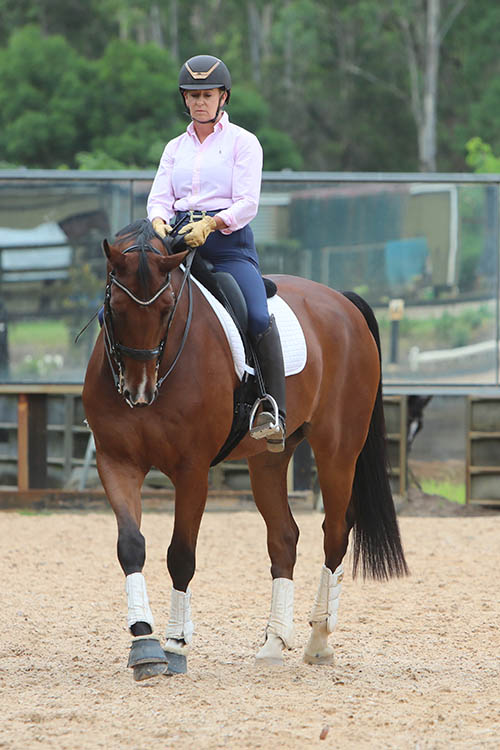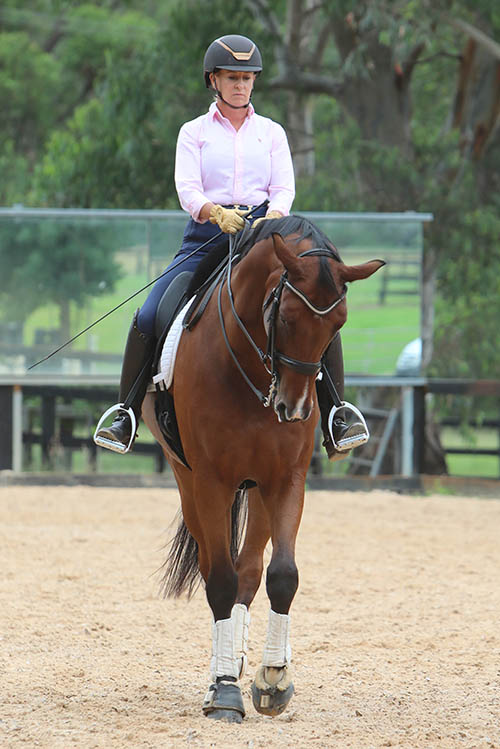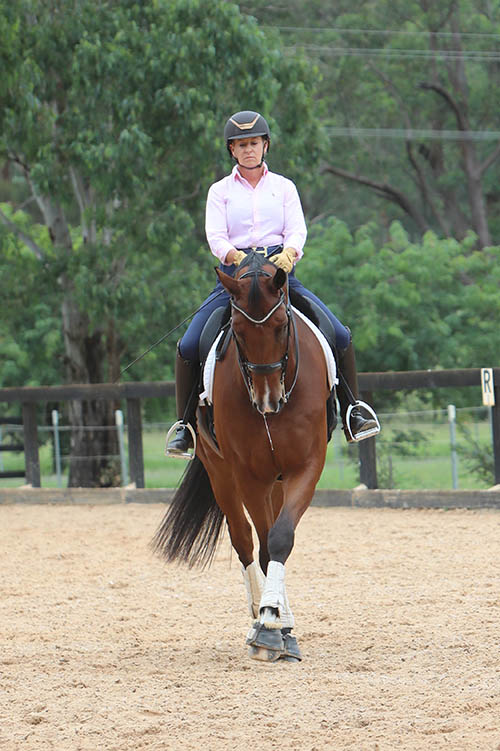The walk pirouette is a complex movement that reflects more on the rider than the horse — and it is one of the hardest exercises in which to score a perfect 10! Let’s see what the experts say.

The FEI describes the walk pirouette as:
“The pirouette (half-pirouette) is a turn of 360 degrees (180 degrees) executed on two tracks, with a radius equal to the length of the horse and the forehand moving around the haunches. The forefeet and the outside hind foot move around the inside hind foot. The inside hind leg describes a circle as small as possible. The horse, slightly bent in the direction in which it is turning, remains “on the bit” with light contact, turning smoothly around, and maintaining sequence and timing of footfalls of that pace. The poll remains the highest point during the entire movement.”
The walk half-pirouette is a movement in tests from Elementary (where it is called a “turn on the haunches” and is basically the same but the size of the pirouette is larger as it is not done from collected walk) right the way through to the Prix St Georges. It is then not in the other FEI tests above Prix St Georges.
It is a movement that is complex and shows very easily the control and degree of balance, throughness and adjustability that the rider can create in the correctly schooled horse. It seems to cause a lot of problems with many horses but really it is simply a rider misunderstanding the concepts involved. There are many ways to start walk pirouettes, and on asking a few prominent riders and coaches, their explanations are easily understood.
DAVID McKINNON
David has had great success on many horses from four-year-olds through to Grand Prix and is a well sought-after coach. He and his wife, Robbie, make a great team and have many horses in work and are constantly at the top of the results list at any competition. Take it from David:
“I like to start the walk pirouettes fairly early in the training but there are always some prerequisites. The horse needs to be on the bit and often with the walk it’s the hardest pace to really establish a good throughness. The horse needs to be in front of the leg with an enthusiasm in the walk. He must understand moving off the leg as in leg-yielding both ways, and then he should be able to make shoulder-in and, most importantly, the travers. The pirouette is basically the smallest turn around the haunches in travers keeping the walk rhythm throughout the movement.
“I like to start by riding travers before the corner and then collecting the walk steps and maintaining the travers through the corner. Then travers along the short side and then again travers through the upcoming corner and so on. For me, the two biggest mistakes that are made in the walk pirouettes are that the horse moves out with the hind leg — and the other is a mistake in the continuity of the walk steps and the rhythm.

“Of course, the end result is also to keep the bend and flexion to the direction of the turn. In the early stages of teaching the pirouette, do not panic about the flexion to the inside too much, but do have a good understanding that the horse respects the outside leg to control the quarters to not move away and, in the beginning, to actually move in a little.
“I always start with a simple quarter turn. I make a square and turn in travers, then straight then again turn. Try always to walk positively forward and do not have a blocked hand as this will create stalling and grounded steps behind! Start with bigger size turns, and only as you feel that you can get the steps actively collected, start to make them smaller. This is an exercise I use a lot, and it’s great for testing the comprehensiveness of the aids. It’s not an easy exercise to score big marks in a test and often it’s hard to even get a 7 let alone any higher! That always mystifies me but I am always in search of that elusive 10 for the movement and work on the pirouettes a lot.
“For sure, this walk one is the prerequisite to the canter pirouette that is trained exactly the same as we train the walk one! Once the basics are in place then it’s important to start the half-pirouette from the slightest shoulder-fore positioning and definitely not in travers. The travers is just the basic way to help the horse understand the principles of the movement and is not the position to start a competition pirouette from. Being honest with you, it’s a hard exercise to do well and one that many riders do not pay enough attention to. Perhaps even me! Good luck.”

“It’s not slow, it’s in fact quick, sharp and,
as the word says, collected!”
CLEMENS DIERKS
Clemens Dierks is internationally respected as an outstanding coach and has produced many Grand Prix riders, not to mention countless Grand Prix horses. He was the national dressage coach for Australia and also had a huge impact on many New Zealand riders who were coached by him. He is a very knowledgeable man of German origins and training and is clear and to the point. Not complicated, he gets the best out of riders and their horses. His wife, Judy, is one of Australia’s greatest riders and responsible for putting Clemens’s words into actions with the many horses that have won national and international competitions.
“Mistakes in walk pirouettes are 99% rider errors,” says Clemens. “The horse should move the forehand around the inside hind leg. The rider’s seat and legs control the position of the horse and the rider’s hands turn the horse. It is simply an exercise of shoulder control, which is controlled by the reins, and body control and energetic steps controlled through the seat and leg position of the rider. The rider’s outside leg is behind the girth to stop the quarters from stepping out — and the inside leg near the girth to keep the energy and forward thinking of the horse.
“I simply start on a circle in travers and make sure there is only a small amount of quarters to the inside, as when you get to make the pirouette, if the quarters are too much to the inside you can never turn the shoulders around the hind end! Eventually the inside hind will simply mark time on the spot as the forehand is directed through the reins to turn with an inside flexion. The outside hind never is allowed to step out and the rider’s inside leg takes care of the balance, bend and energy in the steps.
“The most important thing in this exercise is that, the smaller the pirouette, the better the walk activity and collection must be. This is where so many riders make mistakes in not understanding the clarity of the collection in the walk… it’s not slow, it’s in fact quick, sharp and, as the word says, COLLECTED!”

JENNY GEHRKE
Jenny Gehrke is a Queensland Grand Prix rider, and an extremely well-respected coach of many top riders – including, Jayden Brown (who took over the riding of the outstanding horses at Willinga Park after Brett Parbery moved on). Her principles are very sound and simplistic and easy to follow. When asked about the walk pirouettes and their training, her response was:
“First and foremost, the horse must be on the bit and in front of the leg. You have to be able to stop, go and turn left and right remaining on the bit. Then you must be able to ride shoulder-in and travers. Once all these boxes are ticked and the horse is able to collect and expand the walk, then the pirouettes just fall in to place!
“I will always start making sure that the horse can turn off the outside aids. This is an exercise that Kyra Kyrklund made such an important part of her basic riding and training. To turn off the outside aids, the horse must learn to move the forehand in front of the quarters and the outside rein is of the utmost importance here. To start this, the horse, who knows how to leg-yield, learns to turn right with a slight outside bend and as if leg-yielding the forehand around a turn. This slight outside bend makes it easier in the beginning to learn about the shoulder control in moving the forehand around the quarters. The outside front leg needs to move across the midline of the horse.
“This is basic stuff and is also the real beginning of the pirouette. The horse must be able to make a circle with an outside bend as well as an inside bend and be obedient to the reins and, more importantly, to the rider’s leg and seat that is able to support the horse’s body and balance.
“The first baby pirouettes are taken on a 10-metre circle and to ride a few travers steps then straight on the circle, always making sure the horse is in front of the leg. If he becomes backward it is corrected by an immediate transition to trot. Back to walk and repeat. The next exercise would be travers through a corner, as on a square, and make travers a quarter turn in each corner. Once this control is in place it’s then onto more collection in the walk with active, not slow, steps and small to wider turns until a pirouette evolves.
“The most important thing is the basics before the pirouette and then the horse MUST stay motivated and in front of the leg no matter what. Step by step and attention to simple reactions in the basic work and it simply happens. It’s not the pirouette that is the hard bit — that’s the easy bit — it’s the adjustability and reactions to all I have mentioned that is the important part.”

“The pirouettes are often too large.”
MARIA SCHWENNESEN
The judges’ perspective is also very interesting and important so as the rider and coach have an insight in to what judges are looking for.
Maria Schwennesen is an Australian international 5* judge who has officiated at two FEI World Cup Finals and the Young Horse World Championships twice (and what is to be a third time this year). Pirouettes are a favourite movement of hers to judge, but she has yet to score a 10 for such! These are her thoughts:
“The walk pirouettes certainly show many training positives including throughness, collection, purity of the walk, elasticity and suppleness, balance and, above all, rider understanding and control from the seat to the bridle. I have to say that the biggest fault I seem to pick up on is that the riders allow the horse to lose the balance and take the shoulders around too fast without having the horse balanced in front of, and up from, the rider’s inside leg aid. The seat is most important and often the riders use a rein aid that actually is too strong and a blocking aid that doesn’t allow the forward thinking and loose active steps.
“The pirouettes are often too large and the degree of active collection determines the quality and the size the pirouette can be performed in without mistakes in balance and rhythm and tempo. Of course, the bend and flexion with the collection is what make a good pirouette. The outside hind leg must move forward and towards the inside hind leg, never moving out and never crossing completely past the inside hind leg.
“A fault that is associated with this blocking rein aid is that the steps of the walk can become somewhat lateral, and as with a lateral walk the score can then be an insufficient mark. Lateral walk is a two-beat walk with the legs on the same side moving together instead of the true four-beat walk.
“Again, it is a very complex movement and needs plenty of practice to assess the pirouette in a small space of time. As with every movement, it’s important not to over-assess but to simply look at the overall impression and weigh it up. Your trained eye will give you the word that corresponds to the mark and then remember that you need to say what was missing to make it a 10!” EQ
YOU MIGHT ALSO LIKE TO READ:
‘Training the Rein-Back’ – Equestrian Life, February 2022

